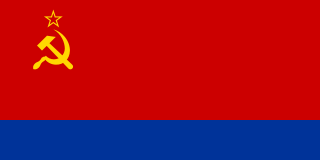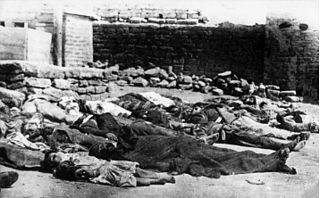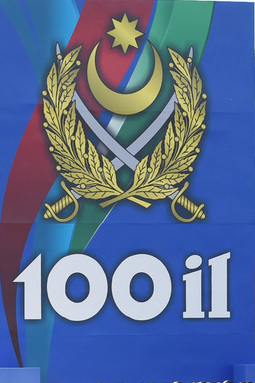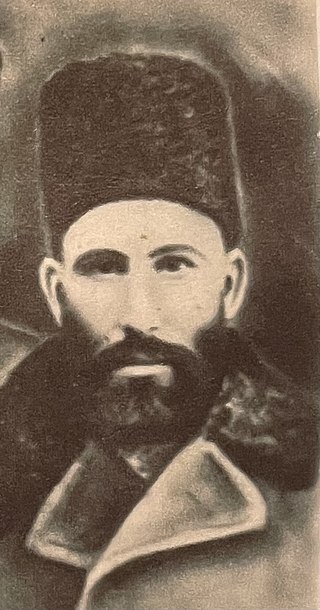
The Azerbaijan Soviet Socialist Republic, also referred to as the Azerbaijani Soviet Socialist Republic, Azerbaijan SSR, Azerbaijani SSR, AzSSR, Soviet Azerbaijan or simply Azerbaijan, was one of the constituent republics of the Soviet Union between 1922 and 1991. Created on 28 April 1920 when the Russian Soviet Federative Socialist Republic brought pro-Soviet figures to power in the region, the first two years of the Azerbaijani SSR were as an independent country until incorporation into the Transcaucasian SFSR, along with the Armenian SSR and the Georgian SSR.

Samad bey Sadykh bey oghlu Mehmandarov was a General of the Artillery in the Russian Imperial Army, a member of the Independence faction of the Parliament of the Azerbaijan Democratic Republic, the Minister of Defense of the Azerbaijan Democratic Republic, and a military figure of the Azerbaijan Soviet Socialist Republic and the Soviet Union.

Marneuli is a city in the Kvemo Kartli region of southern Georgia and administrative center of Marneuli Municipality that borders neighboring Azerbaijan and Armenia.

The March Days or March Events was a period of inter-ethnic strife and clashes which took place between 30 March – 2 April 1918 in the city of Baku and adjacent areas of the Baku Governorate of the Transcaucasian Commissariat.

The Armenian-Azerbaijani war (1918–1920) was a conflict that took place in the South Caucasus in regions with a mixed Armenian-Azerbaijani population, broadly encompassing what are now modern-day Azerbaijan and Armenia. It began during the final months of World War I and ended with the establishment of Soviet rule.

The Red Army invasion of Georgia, also known as the Georgian–Soviet War or the Soviet invasion of Georgia, was a military campaign by the Russian Soviet Red Army aimed at overthrowing the Social Democratic (Menshevik) government of the Democratic Republic of Georgia (DRG) and installing a Bolshevik regime in the country. The conflict was a result of expansionist policy by the Russians, who aimed to control as much as possible of the lands which had been part of the former Russian Empire until the turbulent events of the First World War, as well as the revolutionary efforts of mostly Russian-based Georgian Bolsheviks, who did not have sufficient support in their native country to seize power without external intervention.

The 26 Baku Commissars were Bolshevik and Left Socialist Revolutionary (SR) members of the Baku Commune. The commune was established in the city of Baku, which was then the capital of the briefly independent Azerbaijan Democratic Republic, and is now the capital of the Republic of Azerbaijan. The commune, led by Stepan Shahumyan, existed until 26 July 1918 when the Bolsheviks were forced out of power by a coalition of Dashnaks, Right SRs and Mensheviks.

The Battle of Baku took place in August and September 1918 between the Ottoman–Azerbaijani coalition forces led by Nuri Pasha and Bolshevik–ARF Baku Soviet forces, later succeeded by the British–Armenian–White Russian forces led by Lionel Dunsterville, and saw Soviet Russia briefly re-enter the war. The battle took place during World War I, was a conclusive part of the Caucasus Campaign, but a beginning of the Armenian–Azerbaijani War.
The 1920 Ganja revolt was a popular uprising against the Soviet occupation that took place in Ganja on 26 to 31 May 1920. The goal of the uprising was to liberate Azerbaijan from the Soviet army and put an end to the arbitrariness of the communists. This was the largest rebellion against Soviet rule in Azerbaijan in the 20th century, and caused the most losses. The organisers and leading force of the uprising were officers of the army of the former Azerbaijan Democratic Republic.

The military history of Azerbaijan is framed within thousands of years of armed actions of many other states in the territory encompassing modern Azerbaijan, as well as the shorter history of interventions by the Azerbaijani Armed Forces in conflicts abroad. The Azerbaijanis are the inheritors of the lands of various ancient civilizations and peoples including the indigenous Caucasian Albanians, Iranian tribes such as Scythians and Alans, and Oghuz Turks among others.

Ibrahim bey Musa Agha oghlu Usubov was an Azerbaijani Major General in Russian Imperial Army and Azerbaijan Democratic Republic.

The Red Army invasion of Azerbaijan, also known as the Sovietization or Soviet invasion of Azerbaijan, took place in April 1920. It was a military campaign conducted by the 11th Army of Soviet Russia with the aim of installing a new Soviet government in the Azerbaijan Democratic Republic. This invasion occurred simultaneously with an anti-government insurrection organized by local Azerbaijani Bolsheviks in the capital city of Baku. As a result of the invasion, the Azerbaijan Democratic Republic was dissolved, and the Azerbaijan Soviet Socialist Republic was established.

Day of the Armed Forces of Azerbaijan is a holiday annually celebrated on June 26 in Azerbaijan, by the decree issued by President Heydar Aliyev, to commemorate the Azerbaijani Armed Forces.

The Battle of Goychay or Raid on Goychay, was a series of clashes that took place from 27 June to 1 July 1918, between Ottoman–Azerbaijani coalition forces led by Nuri Pasha and a coalition of the Soviet 11th Army and Armenian Dashnak forces. The initial battle ended on 30 June, but minor clashes continued until 1 July. Despite being outnumbered six to one, the Central Powers were able to defeat the Armenian–Soviet forces before they reached Ganja, the headquarters of the Ottoman Islamic Army of the Caucasus. The Ottoman–Azerbaijani forces seized control of the lands from Goychay to Shamakhi. Armenian–Soviet rule in the region ended as a result of the battle.

The Council of People's Commissars of Azerbaijan was established as the governing body of the Azerbaijan Soviet Socialist Republic. Accounts differ as to whether it was formed on 28 April 1920 or at the First All-Azerbaijan Congress of Soviets, 6-19 May (Kharmandarian). The 11th Red Army had moved into north Azerbaijan following the defeat of General Anton Denikin's Volunteer Army. The Baku Bureau of Kavkraikom of the Russian Communist Party (Bolshevik) had held a joint meeting with the Communist Party of Azerbaijan on 27 April at which they formed the Azerbaijan Revolutionary Committee (Azrevkom). This new body issued an ultimatum to the government of the Azerbaijan Democratic Republic, who immediately surrendered: The Red Army had sent an armoured train directly to Baku which arrived on 28 April. The terms of the surrender passed lawful power to Azrevkom, to whom several key figures had been appointed in their absence. In particular Nariman Narimanov was absent having travelled to Moscow to see Lenin and Stalin and only arrived in Baku on 16 May. Thus although he was declared the chairperson of the AzSovnarkom, this was a role he could only truly assume when he arrived in the middle of the First All-Azerbaijan Congress of Soviets. The senior Bolsheviks responsible for stage managing the foundation of the AzSovnarkom were Sergei Kirov and Grigoriy Ordzhonikidze.

Quba Uprising— the uprising by Azerbaijanis against the Soviet occupation in 1920. Hamdulla Afandi Afandizadeh, Kachak Mail, and ADR army officer Afandiyev were leaders of the uprising which lasted about three weeks. Aliheydar Garayev and Levan Gogoberidze were delegated to the region to suppress the uprising. After weeks of unequal clashes, the rebels were defeated. During the uprising, many villages were burned and 400-500 peasants killed.

Azerbaijani Red Army, also known as the Red Army of Azerbaijan, was a field army of the pro-Bolshevik Red Army in the Azerbaijani Soviet Socialist Republic during the Russian Civil War.

The Battle of Binagadi took place between 26 and 31 August 1918 during World War I and saw Soviet Russia briefly re-enter the war. Ottoman–Azerbaijani coalition forces led by Nuri Pasha fought British–Armenian–White Russian forces led by Lionel Dunsterville. It was an important part of the Battle of Baku.
Battle of Yalama took place on April 28, 1920, in the territory of Yalama between the Yala garrison of the Quba regiment of the National Army of the Azerbaijan People's Republic and the XI Red Army.

Haji Molla Ahmad Nuruzade — also known by the alias Haji Akhund. Haji Molla Ahmad served as a deputy in the parliament of the Azerbaijan Democratic Republic era and was a member of the Musavat Party. He actively resisted the Bolshevik occupation of Azerbaijan and in 1930 shot himself rather than be recaptured by his enemies.















